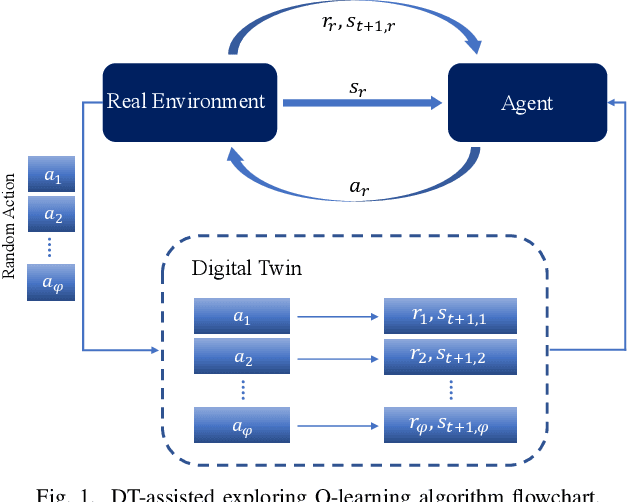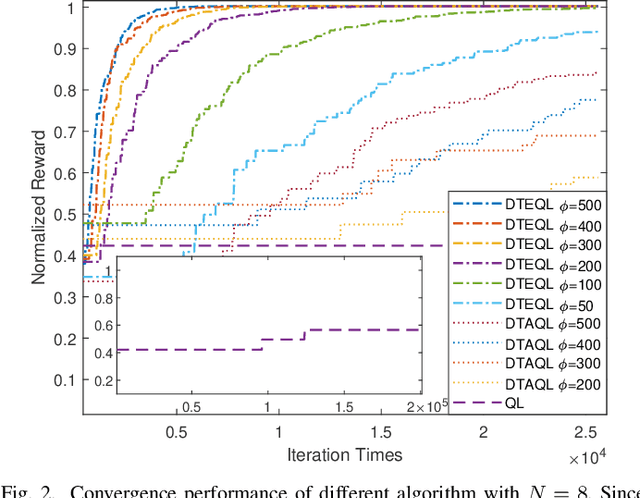Zhisheng Yin
Anti-Intercept OFDM Waveform Design with Secure Coding for Satellite Networks
Apr 30, 2025Abstract:Low Earth Orbit (LEO) satellite networks are integral to next-generation communication systems, providing global coverage, low latency, and minimal signal loss. However, their unique characteristics, such as constrained onboard resources, Line-of-Sight (LoS) propagation, and vulnerability to eavesdropping over wide coverage areas, present significant challenges to physical layer security. To address these challenges, this paper focuses on the design of anti-intercept waveforms for satellite-ground links within Orthogonal Frequency Division Multiplexing (OFDM) systems, aiming to enhance security against eavesdropping threats. We formulate a secrecy rate maximization problem that aims to balance secrecy performance and communication reliability under eavesdropping constraints and sub-carrier power limitations. To solve this non-convex optimization problem, we propose a bisection search-activated neural network (BSA-Net) that integrates unsupervised learning for secure coding optimization and bisection search for dynamic power allocation. The proposed method is structured in two stages: the first optimizes secure coding under power constraints, while the second allocates power across sub-carriers under eavesdropping constraints. Extensive simulation results demonstrate the efficacy of our approach, showcasing significant improvements in secrecy rate performance.
RadioDiff: An Effective Generative Diffusion Model for Sampling-Free Dynamic Radio Map Construction
Aug 16, 2024Abstract:Radio map (RM) is a promising technology that can obtain pathloss based on only location, which is significant for 6G network applications to reduce the communication costs for pathloss estimation. However, the construction of RM in traditional is either computationally intensive or depends on costly sampling-based pathloss measurements. Although the neural network (NN)-based method can efficiently construct the RM without sampling, its performance is still suboptimal. This is primarily due to the misalignment between the generative characteristics of the RM construction problem and the discrimination modeling exploited by existing NN-based methods. Thus, to enhance RM construction performance, in this paper, the sampling-free RM construction is modeled as a conditional generative problem, where a denoised diffusion-based method, named RadioDiff, is proposed to achieve high-quality RM construction. In addition, to enhance the diffusion model's capability of extracting features from dynamic environments, an attention U-Net with an adaptive fast Fourier transform module is employed as the backbone network to improve the dynamic environmental features extracting capability. Meanwhile, the decoupled diffusion model is utilized to further enhance the construction performance of RMs. Moreover, a comprehensive theoretical analysis of why the RM construction is a generative problem is provided for the first time, from both perspectives of data features and NN training methods. Experimental results show that the proposed RadioDiff achieves state-of-the-art performance in all three metrics of accuracy, structural similarity, and peak signal-to-noise ratio. The code is available at https://github.com/UNIC-Lab/RadioDiff.
Imperfect Digital Twin Assisted Low Cost Reinforcement Training for Multi-UAV Networks
Oct 25, 2023Abstract:Deep Reinforcement Learning (DRL) is widely used to optimize the performance of multi-UAV networks. However, the training of DRL relies on the frequent interactions between the UAVs and the environment, which consumes lots of energy due to the flying and communication of UAVs in practical experiments. Inspired by the growing digital twin (DT) technology, which can simulate the performance of algorithms in the digital space constructed by coping features of the physical space, the DT is introduced to reduce the costs of practical training, e.g., energy and hardware purchases. Different from previous DT-assisted works with an assumption of perfect reflecting real physics by virtual digital, we consider an imperfect DT model with deviations for assisting the training of multi-UAV networks. Remarkably, to trade off the training cost, DT construction cost, and the impact of deviations of DT on training, the natural and virtually generated UAV mixing deployment method is proposed. Two cascade neural networks (NN) are used to optimize the joint number of virtually generated UAVs, the DT construction cost, and the performance of multi-UAV networks. These two NNs are trained by unsupervised and reinforcement learning, both low-cost label-free training methods. Simulation results show the training cost can significantly decrease while guaranteeing the training performance. This implies that an efficient decision can be made with imperfect DTs in multi-UAV networks.
Label-free Deep Learning Driven Secure Access Selection in Space-Air-Ground Integrated Networks
Aug 28, 2023Abstract:In Space-air-ground integrated networks (SAGIN), the inherent openness and extensive broadcast coverage expose these networks to significant eavesdropping threats. Considering the inherent co-channel interference due to spectrum sharing among multi-tier access networks in SAGIN, it can be leveraged to assist the physical layer security among heterogeneous transmissions. However, it is challenging to conduct a secrecy-oriented access strategy due to both heterogeneous resources and different eavesdropping models. In this paper, we explore secure access selection for a scenario involving multi-mode users capable of accessing satellites, unmanned aerial vehicles, or base stations in the presence of eavesdroppers. Particularly, we propose a Q-network approximation based deep learning approach for selecting the optimal access strategy for maximizing the sum secrecy rate. Meanwhile, the power optimization is also carried out by an unsupervised learning approach to improve the secrecy performance. Remarkably, two neural networks are trained by unsupervised learning and Q-network approximation which are both label-free methods without knowing the optimal solution as labels. Numerical results verify the efficiency of our proposed power optimization approach and access strategy, leading to enhanced secure transmission performance.
Distilling Knowledge from Resource Management Algorithms to Neural Networks: A Unified Training Assistance Approach
Aug 15, 2023



Abstract:As a fundamental problem, numerous methods are dedicated to the optimization of signal-to-interference-plus-noise ratio (SINR), in a multi-user setting. Although traditional model-based optimization methods achieve strong performance, the high complexity raises the research of neural network (NN) based approaches to trade-off the performance and complexity. To fully leverage the high performance of traditional model-based methods and the low complexity of the NN-based method, a knowledge distillation (KD) based algorithm distillation (AD) method is proposed in this paper to improve the performance and convergence speed of the NN-based method, where traditional SINR optimization methods are employed as ``teachers" to assist the training of NNs, which are ``students", thus enhancing the performance of unsupervised and reinforcement learning techniques. This approach aims to alleviate common issues encountered in each of these training paradigms, including the infeasibility of obtaining optimal solutions as labels and overfitting in supervised learning, ensuring higher convergence performance in unsupervised learning, and improving training efficiency in reinforcement learning. Simulation results demonstrate the enhanced performance of the proposed AD-based methods compared to traditional learning methods. Remarkably, this research paves the way for the integration of traditional optimization insights and emerging NN techniques in wireless communication system optimization.
Digital Twin-Assisted Efficient Reinforcement Learning for Edge Task Scheduling
Aug 02, 2022



Abstract:Task scheduling is a critical problem when one user offloads multiple different tasks to the edge server. When a user has multiple tasks to offload and only one task can be transmitted to server at a time, while server processes tasks according to the transmission order, the problem is NP-hard. However, it is difficult for traditional optimization methods to quickly obtain the optimal solution, while approaches based on reinforcement learning face with the challenge of excessively large action space and slow convergence. In this paper, we propose a Digital Twin (DT)-assisted RL-based task scheduling method in order to improve the performance and convergence of the RL. We use DT to simulate the results of different decisions made by the agent, so that one agent can try multiple actions at a time, or, similarly, multiple agents can interact with environment in parallel in DT. In this way, the exploration efficiency of RL can be significantly improved via DT, and thus RL can converges faster and local optimality is less likely to happen. Particularly, two algorithms are designed to made task scheduling decisions, i.e., DT-assisted asynchronous Q-learning (DTAQL) and DT-assisted exploring Q-learning (DTEQL). Simulation results show that both algorithms significantly improve the convergence speed of Q-learning by increasing the exploration efficiency.
Green Interference Based Symbiotic Security in Integrated Satellite-terrestrial Communications
Jun 06, 2022



Abstract:In this paper, we investigate secure transmissions in integrated satellite-terrestrial communications and the green interference based symbiotic security scheme is proposed. Particularly, the co-channel interference induced by the spectrum sharing between satellite and terrestrial networks and the inter-beam interference due to frequency reuse among satellite multi-beam serve as the green interference to assist the symbiotic secure transmission, where the secure transmissions of both satellite and terrestrial links are guaranteed simultaneously. Specifically, to realize the symbiotic security, we formulate a problem to maximize the sum secrecy rate of satellite users by cooperatively beamforming optimizing and a constraint of secrecy rate of each terrestrial user is guaranteed. Since the formulated problem is non-convex and intractable, the Taylor expansion and semi-definite relaxation (SDR) are adopted to further reformulate this problem, and the successive convex approximation (SCA) algorithm is designed to solve it. Finally, the tightness of the relaxation is proved. In addition, numerical results verify the efficiency of our proposed approach.
 Add to Chrome
Add to Chrome Add to Firefox
Add to Firefox Add to Edge
Add to Edge